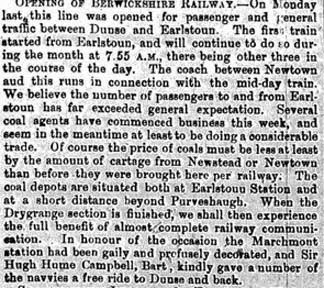As we mark the first anniversary of the return of the Borders Railway, a look back at the early days of the original railway which passed through Earlston 1863-1965, linking the east coast Edinburgh to London route with the historic Waverley line through the central Borders.
Some of the issues reported by local newspapers of the past sound familiar!
THE PLANNING
THE PLANNING
- "The Southern Reporter" of 12th January 1861 reported that the plans were in the hands of parochial teacher Mr. Aitkenhead and available for inspection. The route for the railway was outlined as:
"entering the parish by a bridge across the Leader, then across the fields belonging to Misses Whales (gingham manufacturers), passing the foot of the West U.P. Manse garden, and crossing the road from Earlston to Redpath......
- For farmers, their main concern was for a grain market and a public meeting was held in the Reading Room to progress the matter with banker Mr. Smail appointed honorary secretary. (The Southern Reporter: 12th January 1861)
- Travelling and postal arrangements were also under scrutiny, as noted in "The Southern Reporter" 5th August 1863. Take note of the powerful prayerful language used in their argument to the Railway Directors
"The community of Earlston were impressed with the courteous manner in which Mr George Wallace of the Commercial Inn and proprietor of the present conveyance to and from Melrose had served the public - to often with slight advantage to himself. It was considered it necessary to forward a petition to the Directors praying for him to continue as their postmaster. The petition ash been signed by merchants, traders and other influential parties. Should the Directors deem it fitting to grant the prayer of the petition, their so doing would satisfy the public and confirm a boon on an obliging and industrious public servant."
THE OPENING
Thar the opening was imminent, was reported in "The Southern Reporter" of 29th October 1863. The Government Inspector had passed along the line; the construction company had dismissed a considerable number of their men and the horse stock was authorised for sale.
ACCIDENT
But just one day after the opening of Earlston Railway Station,
"The Kelso Chronicle" of 20th November 1863 headline read "A
Serious Accident on the Berwickshire Railway" near Dunse.
"This line which opened with much promise on Monday, was the scene of
a rather serious mishap on Tuesday. ....A train on its way to Earlston with a
few coal trucks, two carriages and two passengers was startled by the axle of the one of the trucks
giving way and tearing the rails....both carriages and trucks were dragged off
the line, but fortunately none were precipitated over the embankment.........A large force of navvies were on the
line and were exerting themselves to get the line in order again. They intended to work all night and have it
finished for the next day's traffic.........it was necessary to delay trains, much to the annoyance of a great number of passengers attending Dunse Fair.
LEADERFOOT
The major engineering feat on the line was the crossing of the River Tweed and the building of the Leaderfoot Viaduct, which
involved a nineteen
arch structure 907 feet long and 126 feet above the level of the
river bed. Interestingly it is referred to in a newspaper article of
December 1864 as the Drygrange Viaduct.
One of the last trains over Leaderfoot in 1965
Copyright © Bruce McCartney All Rights Reserved.
The item in "The Southern Reporter" of 24th October 1867 may strike a chord.
"The railway arrangements of the North British appeared to be of the most annoying and expensive description...........to our mortification and the chagrin and disgust of between forty and fifty farmers and business men whose time is worth money, we were kept two and a half hours waiting on the train.......The Berwickshire Company may find their small dividend will be reduced to nothing and the public will lose all confidence in the line."
 | |
But the Berwickshire Railway survived. Devastating floods across the county in August 1948 meant that passenger services were suspended, due to parts of the track bed being washed away. Repairs were never fully carried out and only freight services continued on part of the line, which was eventually closed without ceremony on 16th July 1965 - marking the end of the 102 year old line of the Berwickshire Railway through Earlston.
In 1969 amidst the notorious Beeching Cuts, the Scottish Borders lost all
its rail services, making it the only region in mainland Scotland
without a train station. But that all changed in September 2015
when part of the Waverly Line re-opened for 35 miles south of Edinburgh
into the central Borders at Tweedbank.
Steam train arriving at Tweedbank
***************






No comments:
Post a Comment
Thank you for taking the time to comment. Your feedback is much appreciated.